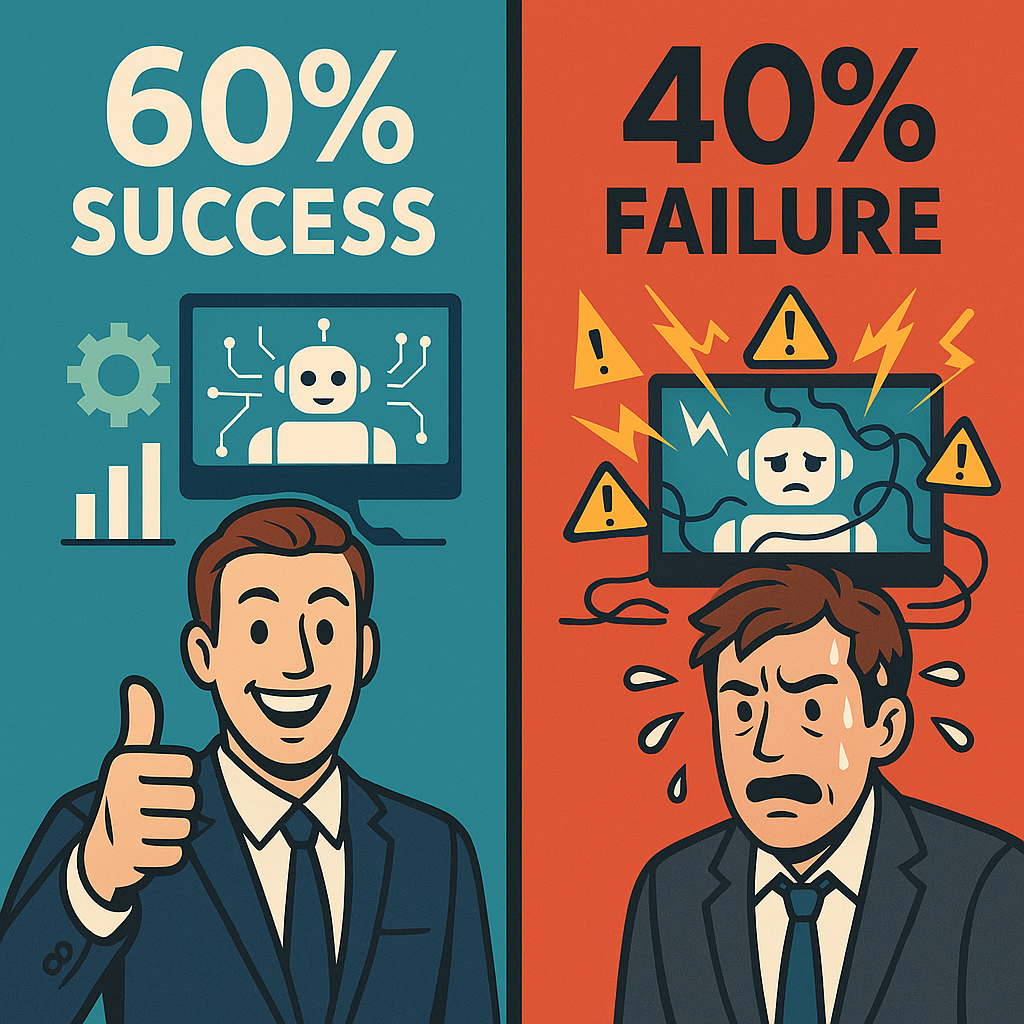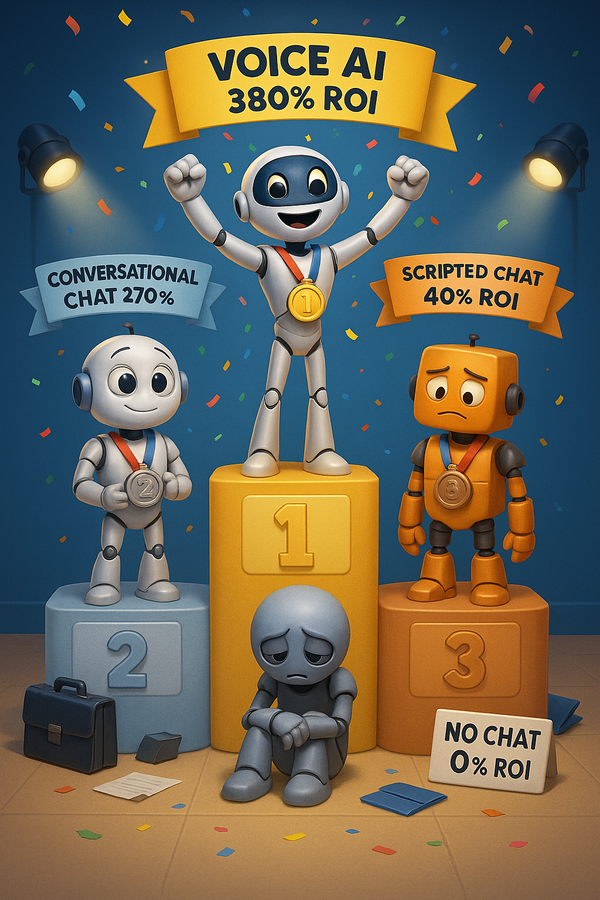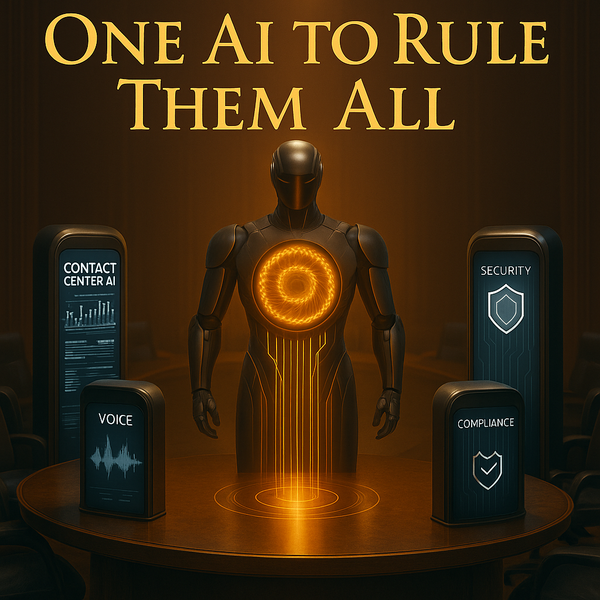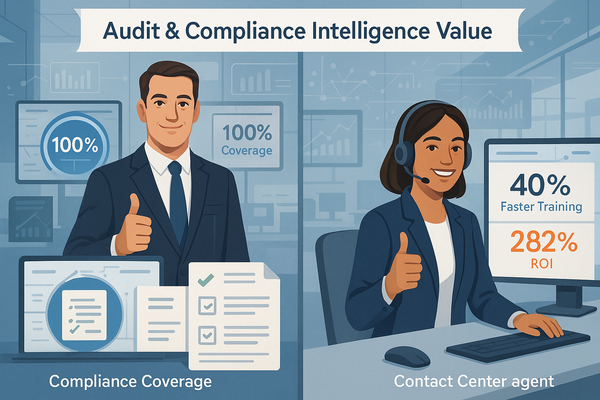The Gen AI Reality Check: Why 40% of Agentic AI Projects Will Fail (And How to Be in the 60%)

Executive Summary: While agentic AI promises revolutionary automation, Gartner's sobering prediction that 40% of projects will fail by 2027 signals a crucial inflection point. The companies that succeed will focus on clear business value, proper integration, and realistic implementation timelines rather than chasing the hype. Success isn't about having the most advanced AI—it's about deploying it strategically.
This Week's Spotlight: The Great AI Reality Check Arrives
The artificial intelligence industry is experiencing its most significant reality check since the generative AI boom began. Gartner predicts that over 40% of agentic AI projects will be canceled by the end of 2027, due to escalating costs, unclear business value or inadequate risk controls. This isn't just another analyst prediction, it's a wake-up call for enterprises investing billions in autonomous AI systems.
The numbers tell a stark story. According to a January 2025 Gartner poll of 3,412 webinar attendees, 19% said their organization had made significant investments in agentic AI, 42% had made conservative investments, 8% no investments, with the remaining 31% taking a wait and see approach or are unsure. Despite this massive investment, the failure rate prediction suggests that most organizations are approaching agentic AI without a clear understanding of its practical limitations.
What Makes This Different from Previous AI Waves
Unlike the generative AI surge that focused on content creation and individual productivity, agentic AI promises something far more complex: autonomous decision-making and action. As McKinsey notes, "in 2025, an AI agent can converse with a customer and plan the actions it will take afterward, for example, processing a payment, checking for fraud, and completing a shipping action". This leap from generating text to taking business-critical actions dramatically increases both the potential value and the implementation complexity.
The failure prediction isn't about the technology's capabilities—it's about organizational readiness. Gartner estimates only about 130 of the thousands of agentic AI vendors are real, highlighting how "agent washing"—the rebranding of existing chatbots and automation tools—is creating false expectations and inflated costs.
Innovation Roundup: Separating Signal from Noise
Microsoft's Computer Use: The Complexity Challenge
Microsoft's announcement of computer use capabilities in Copilot Studio represents both the promise and the peril of current agentic AI development. This new capability allows Copilot Studio agents to treat websites and desktop applications as tools, with agents able to interact with any system that has a graphical user interface—navigating menus, clicking buttons, and typing in fields.
While technically impressive, this advancement illustrates why many agentic AI projects struggle. The gap between "can interact with any GUI" and "reliably performs business-critical tasks without human oversight" represents months or years of testing, refinement, and risk management that many organizations underestimate.
The Cisco Timeline Reality Check
Cisco's research predicts that 68% of customer experience interactions with technology partners will be handled using agentic AI within the next three years seems aggressive given Gartner's failure predictions. However, the key lies in Cisco's approach: they're focusing on specific, measurable use cases rather than broad automation promises.
A striking 93% of respondents predict that agentic AI will enable more personalized, proactive, and predictive services, while 89% of customers emphasize the need to combine human connection with AI efficiency. This human-AI balance will likely determine which companies end up in the successful 60%.
The Infrastructure Awakening
According to recent analysis, "Just as your overall AI strategy relies on a robust data foundation, the success of your agentic AI initiatives hinges on seamless integration with your existing IT infrastructure". Many failing projects underestimate this integration complexity, treating agentic AI as a standalone solution rather than a system that needs to work within existing enterprise architecture.
Implementation Deep Dive: Tale of Two Approaches
The Failed Approach: Technology-First Implementation
Consider a mid-market insurance company that invested $2.3 million in an agentic AI platform to automate claims processing. The project, launched in early 2024, was canceled after 18 months. The failure points were predictable:
- Unclear ROI Definition: The business case focused on "80% automation" without defining what tasks would be automated or how success would be measured
- Integration Underestimation: AI required connections to 14 different legacy systems, each requiring custom API development
- Change Management Neglect: Claims adjusters weren't trained on working with AI, leading to resistance and workarounds
- Scope Creep: The initial focused use case expanded to "revolutionize all claims processing," creating unrealistic expectations
The Successful Approach: Business-Value-First Implementation
In contrast, a regional bank's customer service automation project exemplifies the winning formula. Starting with a $150,000 pilot focused solely on balance inquiries and transaction history, they achieved:
- Clear Success Metrics: 70% automation rate for specific query types, with sub-30-second response times
- Phased Integration: Connected to customer database first, then gradually added account management systems
- Human-Centric Design: Following a "human-in-the-loop" approach, agents remained central to complex interactions while AI handled routine tasks
- Measured Expansion: After six months of stable operation, they expanded to password resets and simple account updates
The difference? The successful implementation treated agentic AI as a business process improvement tool, not a technology showcase.
Architecture Blueprint: Building Agentic AI That Actually Works
Foundation: Value-Driven Design Principles
Successful deployment requires identifying the best uses for agents by evaluating two key factors — value and trust. This framework should guide every architectural decision:
Value Assessment Matrix:
- High-Volume, Low-Complexity Tasks: Password resets, balance inquiries, appointment scheduling
- Clear Success Metrics: Response time, completion rate, customer satisfaction
- Measurable Cost Reduction: Specific FTE hours saved, call deflection rates
- Revenue Impact: Upsell opportunities, customer retention improvements
Trust Architecture Components:
- Audit Trails: Complete logging of all AI decisions and actions
- Rollback Capabilities: Ability to reverse AI actions when errors occur
- Human Escalation: Clear triggers for when human intervention is required
- Compliance Controls: Built-in guardrails for regulated industries
Technical Architecture: Start Simple, Scale Smart
Phase 1: Proof of Concept (Months 1-3)
Customer Inquiry → Intent Classification → Knowledge Base Search → Response Generation
↓
Human Review (100% of responses)
Phase 2: Controlled Automation (Months 4-8)
Customer Inquiry → Intent Classification → Confidence Score Assessment
↓ ↓
High Confidence (Auto-respond) Low Confidence (Human Review)
↓ ↓
Direct Resolution Agent-Assisted Response
Phase 3: Intelligent Orchestration (Months 9-18)
Customer Inquiry → Multi-Agent Assessment → Dynamic Routing
↓ ↓
Simple Queries → Basic Agent Complex Issues → Specialized Agent
↓ ↓
Auto-Resolution Advanced Agent + Human Collaboration
Integration Strategy: API-First Architecture
AI agents need to interact seamlessly with existing systems and data sources across the enterprise to function effectively. The winning architecture prioritizes:
- Microservices Design: Each AI capability as an independent service
- Event-Driven Communication: Real-time data flow between systems
- Centralized Monitoring: Unified dashboard for all AI agent activities
- Gradual System Connection: One integration at a time, with thorough testing
Performance Benchmarks for Success
Minimum Viable Performance (MVP Targets):
- Task Completion Rate: 85% for defined use cases
- Response Accuracy: 95% for factual inquiries
- Escalation Rate: <15% to human agents
- Customer Satisfaction: 4.0/5.0 or higher
Production Excellence Targets:
- Task Completion Rate: 92%+
- Response Accuracy: 98%+
- Escalation Rate: <8%
- Average Resolution Time: Sub-60 seconds for routine tasks
Future Tech Watch: Beyond the Hype Cycle
The Maturation Timeline
According to the 2024 Gartner Hype Cycle for Emerging Technologies, generative AI is nearing the "Trough of Disillusionment" after peaking in inflated expectations, while agentic AI (Autonomous Agents) is rising up the "Innovation Trigger" slope. This suggests we're entering a period where practical implementation matters more than theoretical capabilities.
Multi-Agent Orchestration: The Next Frontier
Microsoft AutoGen is redefining the way we build autonomous, event-driven systems, specializing in orchestrating multiple AI agents to solve complex problems in a distributed environment. The companies that master multi-agent coordination will likely dominate the successful 60%.
Expected breakthrough applications for 2025-2026:
- Specialized Agent Teams: Sales agent + technical agent + billing agent working together
- Context Handoffs: Seamless customer context transfer between different AI specialists
- Dynamic Problem-Solving: Agents that can recruit other agents based on problem complexity
Small Language Models: The Efficiency Revolution
Small Language Models (SLMs) offer a compelling alternative to their larger counterparts, with their compact size making them cost-effective, fast, and ideal for resource-constrained environments. This trend will likely separate successful implementations from failures, as organizations realize that bigger isn't always better.
What This Means for Your Business
The 60% Success Formula
The organizations that avoid the 40% failure rate share common characteristics:
- Business-First Thinking: ROI defined before technology selection
- Phased Implementation: Start small, prove value, then scale
- Integration Realism: Understand and plan for system complexity
- Human-Centric Design: 89% of customers emphasize the need to combine human connection with AI efficiency
- Change Management: Train teams working with AI, not just deploying it
Immediate Action Framework
Week 1-2: Reality Assessment
- Audit current AI initiatives for clear business value
- Identify specific processes (not departments) for automation
- Calculate realistic ROI based on comparable implementations
Month 1: Pilot Design
- Select one high-volume, low-complexity use case
- Define success metrics in business terms (cost savings, time reduction)
- Plan integration with maximum two existing systems
Month 2-3: Controlled Testing
- Deploy with 100% human review initially
- Measure performance against defined metrics
- Document integration challenges and solutions
Month 4-6: Gradual Autonomy
- Reduce human review for high-confidence scenarios
- Expand to adjacent use cases if metrics are met
- Build organizational confidence through demonstrated success
The Competitive Advantage Window
Statista predicted that the market value of agentic AI will grow from $5.1 billion U.S. dollars in 2025 to over $47 billion by the end of 2030. However, this growth will primarily benefit organizations that implement thoughtfully rather than quickly.
The window for competitive advantage lies not in being first to deploy agentic AI, but in being first to deploy it successfully. Companies that focus on sustainable business value over technological sophistication will dominate the successful 60%.
Week Ahead: Critical Developments to Monitor
Microsoft Build Follow-ups: Watch for practical case studies and implementation guides as Microsoft's computer use capabilities move beyond demo stage.
Enterprise Adoption Metrics: Q1 2025 earnings calls will likely reveal which Fortune 500 companies are scaling agentic AI beyond pilot programs.
Regulatory Developments: Financial services and healthcare sectors will likely announce specific guidelines for autonomous AI decision-making.
Vendor Consolidation: With only 130 real agentic AI vendors among thousands of claims, expect significant market consolidation as enterprises demand proven solutions over promises.
The 40% failure prediction isn't a condemnation of agentic AI—it's a roadmap for success. The organizations that heed these warnings and focus on practical business value over technological excitement will emerge as the winners in the autonomous AI revolution.
Sources and References
[1] Gartner Press Release, "Gartner Predicts Over 40% of Agentic AI Projects Will Be Canceled by End of 2027," June 25, 2025
[2] Cisco Newsroom, "Agentic AI Poised to Handle 68% of Customer Service and Support Interactions by 2028," May 27, 2025
[3] McKinsey, "Superagency in the workplace: Empowering people to unlock AI's full potential at work," January 28, 2025
[4] Microsoft Copilot Blog, "What's new in Copilot Studio: April 2025," May 19, 2025
[5] Sirocco Group, "The rise of Agentic AI: From generation to action in 2025," January 15, 2025
[6] WillowTree, "Agentic AI: Enhancing Enterprise Workflows in 2025," 2025
[7] IBM Think, "AI Agents in 2025: Expectations vs. Reality," January 2025
[8] Atera Blog, "12 Agentic AI Predictions for 2025," January 2025
[9] Olive Technologies, "Top Agentic AI Platforms in 2025: The Ultimate Guide for Businesses," April 1, 2025
[10] Deloitte Insights, "Autonomous generative AI agents," November 18, 2024



